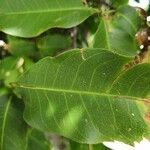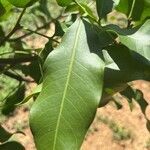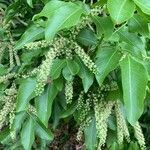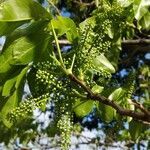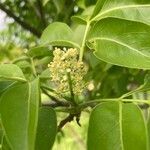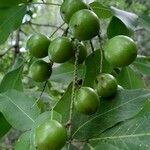Polygamous, deciduous, slow-growing trees, 6-20 m tall; trunk to 60 cm d.b.h., slightly angled and fluted, the bark gray, smooth, the inner bark orange brown, granular; stems grayish, glabrous. Leaves paripinnate, to 26 cm long; petioles 1.5-7 cm long, sometimes winged near the apex; rachis winged or not; leaflets 2-4, elliptic to ovate-elliptic, acute to acuminate, acute and inequilateral at the base, nearly sessile, 7-14 cm long, 2.5-6 cm wide. Inflorescences terminal, the branches slender; racemes many flowered, simple or paniculate; pedicels slender, to ca. 3.5 mm long. Flowers white, 6-8 mm diam.; calyx deeply 4-or 5-lobed; petals obovate, to 3 mm long, ciliolate; disc broadly spreading, glabrous, weakly lobed; stamens 8-10; staminate flowers with the stamens to 3.5 mm long, the pistil lack-ing; bisexual flowers with the stamens to ca. 1.5 mm long, the ovary shorter than the petals, ovate, abruptly narrowed at the apex beneath the capitate, 2-lobed stigma. Drupes green to pale yellow, globose, 2-3 cm diam., the pericarp ca. 2 mm thick, smooth, the mesocarp yellowish, translucent, sweet and juicy; seeds globose, 1.5-2 cm diam.
Glabrous tree to 25 m. tall and bole to 1.7 m. diameter, with spreading branches and smooth grey bark.. Leaves 10–16 cm. long; rhachis flattened above, not winged; leaflets in 2–3 pairs, the lower ovate, ± 5–8(–12) cm. long, 2–4(–6) cm. wide, the upper elliptic-lanceolate to elliptic, 8–11 cm. long, 2.5–5 cm. wide, acute; in young and vigorous leaves the petiole and rhachis may be ± broadly winged and leaflets up to 18 cm. long, 8 cm. wide.. Male inflorescences with several elongate racemose branches, 6–10 cm. long; female usually ± simple.. Flower whitish, 5–8 mm. wide.. Fruits green or yellow, sub-globose, plum-like, 2.5 cm. long, 1.5–2.5 cm. wide, with rather scanty flesh; seed yellowish white, large or 2 hemispherical seeds; aril salmon-coloured or yellowish.
A large evergreen tree. It grows up to 20 m tall. The trunk is smooth and pale grey. The inner bark is orange-brown. The crown is dense, round and compact. Trees are separately male and female. Where bisexual flowers occur these normally do not set fruit unless cross pollinated. The flowers are small and greenish. They are in crowded, long stemmed clusters. The fruit is medium sized with green skin and white or yellow pulp. They are 3 cm across. The skin is tough. There is one seed inside. Fruit hang in clusters near the end of branches and look like grapes. There are several named cultivated varieties.
